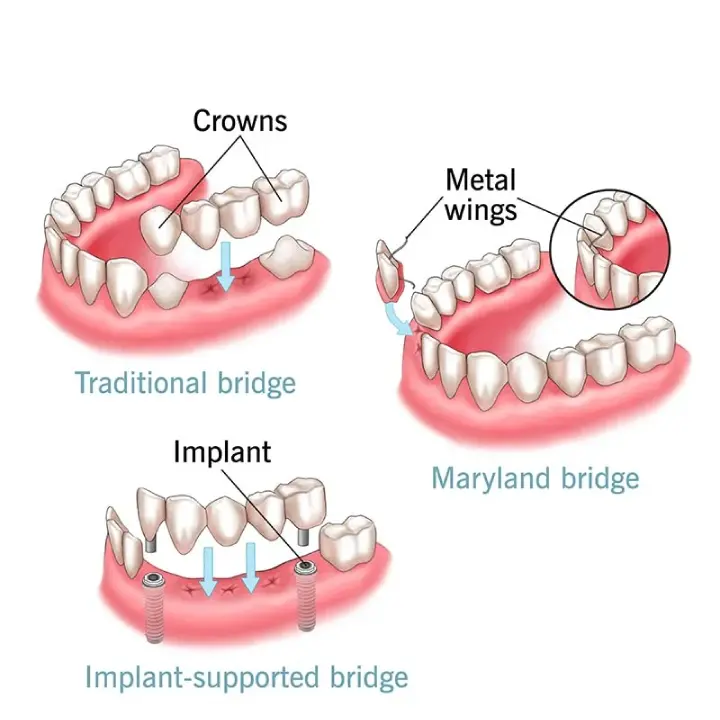
Dental bridge
When you’ll need a dental bridge
Your teeth are designed to work together to help you chew, speak and smile. However, if you lose a tooth, the neighboring teeth can shift or become crooked. This can impact your ability to speak and chew.
Not to mention, it can hinder your ability to effectively clean your teeth, putting you at a greater risk for developing tooth decay and gum disease.
How dental bridges work
Traditional bridges are made up of a collection of crowns (called retainer teeth) and one or more pontics, which are artificial teeth that take the place of the missing ones. In a traditional bridge, the pontic is secured by two or more crowns.
Small titanium fixtures surgically implanted into the jawbone hold an implant-supported bridge in place. This type of bridge provides a smile solution that is both predictable and long-lasting. Unlike other bridges, they do not need support from the surrounding teeth. This is oftentimes the preferred solution when multiple teeth in a row are missing.
Cantilever bridges are similar to traditional dental bridges but only use teeth on one side to help secure the replacement tooth. Since this option isn’t as strong as a fixed bridge, cantilever bridges are sometimes used to fill gaps closer to the front of the mouth. * We do not offer cantilever bridges *
Maryland dental bridges use metal, porcelain, and/or ceramic wings to bind a replacement tooth to the backs of adjoining, natural teeth. Your dentist may opt for this approach for patients whose health makes them a poor candidate for a more invasive procedure—or as a temporary fix while awaiting a more permanent solution, such as when an implant is healing. * We do not offer Maryland bridges *

Scheduling a dental bridge appointment
Successful bridge dentistry can take several trips to the dentist.
During your first visit, you’ll work with your Celebrarte Dental team to create a personalized care plan. They’ll perform any preliminary scans and you’ll get a temporary bridge while we craft your permanent one.
At your second visit, we’ll fit, adjust and install your permanent bridge so that it feels natural. Once the bridge is properly fitted, it will be sealed into place and you’ll enjoy a refreshed smile.
Dental bridges FAQ’s
What is a dental bridge?
A dental bridge contains an artificial tooth that can fill the gap of a missing tooth. The new tooth is secured into place by two crowns on either side of it. Dental bridges can also help restore your smile by preventing any loss of facial structure.
Why might I need dental bridge?
Dental bridges can be a great remedy for filling missing teeth and preserving your mouth and facial structure. For example, if you’re missing a tooth in the lower jaw, a tooth in your upper jaw may shift down into the new space. This is how your smile can become misaligned, changing the shape of your mouth and putting uncomfortable stress on your teeth and jaw joints.
To prevent these oral health issues, it’s best to address a missing tooth proactively with your Celebrate Dental care team—which is where a dental bridge can help.
How long does it take to get a dental bridge?
During your first visit, your Celebrate Dental care team prepares each tooth on either side of the gap. Afterward, they will make an impression, or a digital scan, of your teeth to craft a bridge that will fit specifically to your smile.
Your dentist will then place a temporary bridge to protect your teeth while your permanent dental bridge is being constructed. Once the permanent bridge is finished, it’s time to revisit your local Celebrate Dental to have it fitted and adjusted. After everything fits comfortably, the permanent bridge will be secured into place using dental cement.
What effects the cost of a dental bridge?
Because of the varying factors involved, costs for bridges can fluctuate depending on your unique situation. A few things that can impact cost are the number of teeth being replaced, what the bridge is made of, your dental insurance coverage, your dentist’s financing, as well as any additional procedures needed to complete dental bridge treatment.
What are the pros and cons of a dental bridge?
Dental bridges offer many benefits. But there are some drawbacks, too:
Advantages of dental bridges
Dental bridges can:
- Offer a natural-looking solution for tooth loss.
- Restore chewing and speech function (missing teeth can make it difficult to eat or speak properly).
- Prevent neighboring teeth from shifting into the gap left behind by missing teeth.
Disadvantages of dental bridges
Dental bridges also have some drawbacks:
- If decay or trauma results in damage to your abutment teeth, it can weaken your dental bridge.
- If your abutment teeth aren’t strong enough to support your bridge, they can fracture.
- If you don’t properly clean the bridge and underlying gum tissue, plaque and bacteria can cause gum inflammation or cavities.
How long does it take to recover after a dental bridge procedure?
Recovery times vary from person to person and depend on several factors. On average, it takes one to two weeks for your teeth and gums to heal. But it can take a little longer for your new dental bridge to feel totally natural and comfortable.
How long does a dental bridge last?
On average, the lifespan of a dental bridge is five to 15 years. Some can last even longer with proper care and maintenance.
You may hear dentists call these “permanent bridges.” They’re permanent in the sense that only a dentist can remove them. But they don’t last forever. You’ll still need to replace them when they show signs of wear or damage.
How can I care for my dental bridge?
Caring for a dental bridge is similar to caring for your natural teeth. To keep your bridge in good condition:
- Brush and floss daily.
- Use a nonabrasive fluoride toothpaste.
- Clean underneath your bridge every day using floss threaders or interproximal brushes (tiny brushes made to go between your teeth).
- Avoid extremely hard or chewy foods.
- Don’t chew on ice, pens, pencils or your fingernails.
- Visit your dentist regularly for checkups and cleanings.
When should I call my dentist?
You should schedule an appointment with your dentist if:
- Your bridge is loose or has visible cracks.
- You have pain when chewing.
- You develop teeth sensitivity or sore, bleeding gums.
Dental bridge vs. implant: Which is better?
In general, dental implants last much longer than bridges. Implants also preserve existing bone and reduce the risk of bone loss in the future.
However, everyone has unique oral health needs, goals and preferences. To determine which treatment option is best for you, talk to your dentist.
What’s the ideal age for a dental bridge?
Most dentists don’t place dental bridges in people younger than 17 or 18, but there are exceptions. For example, a dentist may place a Maryland bridge if a child loses a permanent tooth. Even then, other options may work better, such as a temporary partial denture (sometimes called a “flipper”).
How many teeth can be on a bridge?
Most commonly, a dental bridge replaces one to three teeth in a row. In some cases, a bridge can replace up to four consecutive teeth. But keep in mind, longer bridges usually require more support. So, to replace four missing teeth with a bridge, you need healthy natural teeth on both sides of the gap.
To learn more about your teeth replacement options, talk to a dentist.
How long can you wait to get a dental bridge?
In general, you should replace missing teeth as soon as possible to prevent other teeth from shifting into the gap. However, if you need tooth extraction first, you might have to wait a few months before getting your dental bridge. This gives your gums and underlying bone time to heal.
Is a dental bridge painful?
Getting a dental bridge shouldn’t hurt. Your dentist will give you local anesthesia to numb your gums before beginning your procedure.
Do bridges feel like real teeth?
It can take some time to get used to your new dental bridge. But once you do, it should feel similar to your natural teeth. It’s like wearing a new ring on your finger. You’re aware of it for a while, but you eventually grow accustomed to it.
Can a dental bridge be removed and recemented?
It depends. If your bridge is already loose, it’s usually easy to remove. Your dentist can often recement it with no issue. But if you need to have your bridge removed for another reason — like treating gum disease or underlying tooth decay — your bridge may break during the removal process. If this happens, you’ll need a new dental bridge.
Medical references and resources
Dental Bridges: Types & Who Needs Them – https://my.clevelandclinic.org/health/treatments/10921-dental-bridges
Dental Bridge: 4 Types, Benefits, Use Case and Costs – https://www.healthline.com/health/dental-bridge
An Overview of Dental Bridges to Replace Missing Teeth – https://www.webmd.com/oral-health/dental-health-bridges
Types of Dental Bridges – https://www.news-medical.net/health/Types-of-Dental-Bridges.aspx
Dental Bridges and Types of Tooth Bridges – https://www.aspendental.com/dental-services/dental-bridges/
Bridge (dentistry) – Wikipedia – https://en.wikipedia.org/wiki/Bridge_(dentistry)
Bridges, implants, and dentures – The Journal of the American Dental Association – https://jada.ada.org/article/S0002-8177(15)00435-3/fulltext
Bridges | MouthHealthy – Oral Health Information from the ADA – https://www.mouthhealthy.org/all-topics-a-z/bridges
Mayo Dental and Implant Clinic – Bridges – https://www.mayodentalclinic.com/services/restorative/bridges/
Dental bridge: Uses, types, recovery, and more – https://www.medicalnewstoday.com/articles/327182
Our Doctors’ Affiliations






